Abstract
The usefulness of a heat sensitivity test which involved performing an ATP assay on endoscopic biopsy materials for predicting the clinical response to hyperthermia was investigated in esophageal cancer patients. Following in vitro heat treatment of FM3A tumor cells, the heat sensitivity detected by ATPA was significantly correlated with that in the colony-forming assay, and the percent inhibition of the ATP level in the tumor cells was correlated with in vivo tumor growth. The heat sensitivity of the biopsy materials evaluated by ATPA correlated well with that of the resected specimens in 18 esophageal cancer patients, while the clinical response to thermal therapy was well predicted by the heat sensitivity of the biopsy materials evaluated by ATPA in seven of the patients. These results indicate that the heat sensitivity test conducted by performing an ATPA on endoscopic biopsy materials could be a useful indicator for predicting the clinical response to thermal therapy.
Similar content being viewed by others
References
Sugimachi K, Matsuda H (1988) Progress made to date and prospects in hyperthermia for the treatment of maligant tumors. Jpn J Hyperthermic Oncol 4:79–98
Brustad T, Rofstad EK (1988) Effects of heat treatment in vitro and in vivo human melanoma xenografts. Recent Results Cancer Res 109:183–197
Hinkelbein W, Bruggmoser G, Wurdinger A, Fiebig HH (1988) Intrinsic thermosensitivity of various human tumors. Recent Results Cancer Res 109:198–202
Marie JP, Thevenin D, Zittoun R (1989) In vitro sensitivity of normal and leukemic myeloid clonogenic cells to hyperthermia: absence of selective effect. Exp Hematol 17:809–811
Murphy PB, Richman CM (1989) Normal and malignant human myeloid progenitors differ in their sensitivity to hyperthermia. Exp Hematol 17:1105–1109
Rofstad EK (1990) Heat sensitivity and thermotolerance in vitro of human breast carcinoma, malignant melanoma and squamous cell carcinoma of the head and neck. Br J Cancer 61:22–28
Ohno S, Morita M, Tsutsui S, Matsuura H, Kuwano H, Maehara Y, Sugimachi K (1990) Correlation between hyperthermoradio-sensitivity and clinical effect in carcinoma of the esophagus. Surg Gynecol Obstet 171:472–476
Mori M, Maehara Y, Inoue T, Shimano R, Kuwano H, Sugimachi K (1990) Sensitivity to heat and radiation of human rectal malignant tissues in vitro. Dis Colon Rectum 33:590–593
Woo SY, Rice GC, Kapp DS, Hahn GM (1988) A predictive assay for human tumor cellular response to hyperthermia using dansyl lysine staining and flow cytometry. Int J Radiat Oncol Biol Phys 14:361–365
Ichihashi H, Nogaki M, Yamaguchi M, Takagi H, Kondo T, Ozawa T (1986) A simple and rapid in vitro test for determining sensitivity of cancer cells to anticancer drugs. Jpn J Surg 16:380–383
Kangas L, Gronroos M, Nieminen AL (1984) Bioluminescence of cellular ATP: a new method for evaluating cytotoxic agents in vitro. Med Biol 62:338–343
Hirai T, Kawano K, Hirabayashi N, Nishiyama M, Yamashita Y, Mukaida H, Iwata T, Toge T (1991) A novel in vitro chemosensitivity test using materials collected by endoscopic biopsy. Anticancer Drugs 2:261–274
Mukaida H, Hirai T, Nakamura T, Yamashita Y, Kawano K, Toge T, Niimoto M, Hattori T (1988) Measurement of epidermal growth factor receptor and its effect on the growth of human esophageal cancer xenografts implanted into nude mice (in Japanese with English abstract). Oncologia 21:55–60
Cortenay VD, Mills J (1978) An in vitro colony assay for human tumor grown in immune-suppressed mice and treated in vivo with cytotoxic agents. Br J Cancer 37:261–268
Matsuda H, Sugimachi K, Ohno S, Mori M, Kuwano H, Maehara Y (1989) Hyperthermo-chemo-radiotherapy for patients with carcinoma of the esophagus and prediction of the clinical remedial value using the in vitro succinate dehydrogenase inhibition test. Jpn J Cancer Chemother 16:932–937
Author information
Authors and Affiliations
Rights and permissions
About this article
Cite this article
Hirai, T., Iwata, T., Hirabayashi, N. et al. Clinical usefulness of an ATP heat sensitivity test using endoscopic biopsy materials from esophageal cancer patients. Surg Today 25, 684–689 (1995). https://doi.org/10.1007/BF00311483
Received:
Accepted:
Issue Date:
DOI: https://doi.org/10.1007/BF00311483




